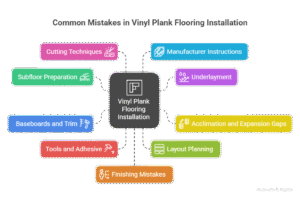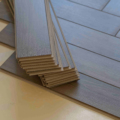The most frequent errors include poor subfloor preparation, failing to let the planks acclimate, skipping or misusing underlayment, not leaving expansion gaps, ignoring manufacturer instructions, and improper layout or cutting. These mistakes – along with not removing baseboards, using wrong tools or adhesive, and rushing the job – often lead to buckling, gaps, or an uneven finish. Below we’ll explain each issue in detail and how to avoid it.
Poor Subfloor Preparation
One of the biggest pitfalls is installing on a subfloor that’s dirty, uneven, or damp. As experts note, vinyl planks won’t hide bumps or debris; any imperfection underfoot can telegraph through the new flooring. Always start by cleaning and leveling the subfloor. Sweep or vacuum thoroughly, fill in dips with leveling compound, and make sure the surface is completely dry. In fact, Bunce Buildings warns that neglecting this step can cause the planks to “warp or buckle” later. If you have old flooring (like tile or laminate), remove it or ensure it’s sound and level before proceeding
Skipping Underlayment
Many vinyl plank products include a built-in underlayment, but when they don’t, skipping a proper underlayment is a common mistake. An underlayment adds cushioning, sound dampening, and sometimes moisture protection. The Tile Shop cautions that failing to use the right underlayment (or using none at all) can lead to unevenness and noise. If your planks require it, lay a quality underlayment before clicking or gluing down the planks. This extra layer will help smooth minor subfloor imperfections and keep the floor feeling solid and quiet over time.

Ignoring Acclimation and Expansion Gaps
Vinyl is sensitive to temperature and humidity. A very common error is not acclimating the planks in the room first. Manufacturers (and guides) strongly recommend leaving unopened cartons of vinyl planks in the installation area for at least 24–48 hours. This lets them adjust to the room’s conditions and prevents later warping or gaps. Equally important is leaving expansion gaps around the walls and fixed objects. As Bunce Buildings explains, vinyl expands and contracts, so you need about a ¼‑inch gap along edges. Without this gap, even small temperature changes can force the planks together and cause buckling or cupping. Use spacers or wedges during installation to maintain this consistent gap, then cover it with trim.
Not Removing Baseboards and Trim
Some DIYers think they can just install planks right up to existing trim, but failing to remove baseboards or undercut door frames is a recipe for ugly edges. The Tile Shop warns that keeping baseboards on during installation “can result in an uneven and unprofessional finish”. Instead, carefully remove or unfasten all baseboards and trim before you begin. You can lay the new planks tight against the wall so the trim can be reinstalled on top for a clean look. Remember to undercut door jambs (cut them shorter) so the plank can slide underneath for a neat fit. Overlooking this step often forces awkward cuts or gaps at the room’s edges.
Using Wrong Tools or Adhesive
Installing vinyl plank flooring requires the right tools. Using dull blades or household knives can produce jagged cuts; a sharp utility knife or vinyl cutter is essential. Also, be cautious with adhesive. For glue-down planks, using the wrong glue or too much adhesive is a common mistake. The Tile Shop notes that not spreading adhesive evenly (or using an incompatible glue) can damage the flooring. Always use the glue recommended by the flooring manufacturer and follow the spread rate they specify. If you have click-lock (floating) planks, don’t use any glue – just snap them together. In short, invest in proper tools (tape measure, tapping block, spacers, knee pads, etc.) but don’t overdo “fancy” gadgets; you mainly need the basics done right.
Poor Layout Planning and Alignment
A lack of planning can doom an install from the start. Before you lay any plank, plan your layout on paper or with a dry “mock” run. Measure the room and decide plank direction. If you dive in without planning, you might end up with tiny slivers of plank on one side or seams lining up awkwardly. Always aim to stagger the seams (offset end-joints by at least a few inches between rows) for strength and a natural look. Quantify Flooring points out that snapping a chalk line and checking your alignment as you go helps prevent an entire floor from creeping off-line. Also, think about where light comes in – running planks along the longest wall or toward the main window usually looks best. Trying to align planks perfectly to corners or splitting rows unevenly is a classic misstep. Take time now to avoid having a last row that’s too narrow; if it is, you might need to adjust the starting wall or cut planks wider to balance both edges.
Improper Cutting Techniques
Mistakes often happen at the finishing stages. Incorrect cuts around vents, outlets, or tight corners can spoil the look. Always measure twice, cut once, and use a straight edge. The Tile Shop advises using a utility knife with a ruler or a fine-tooth saw for complicated shapes. Avoid ripping planks with rough saws that can splinter the edges. Practice on a scrap if needed: score the plank surface deeply with your knife, snap it cleanly, and then trim as needed. A clean, precise cut keeps the seams tight. Similarly, placing a very small piece at the end of a run – so small you can’t insert your spacer – is a common rookie mistake. If the last row would be too thin (for example less than 2 inches), you should readjust the starting row width so both edges finish evenly.
Ignoring Manufacturer Instructions
Each vinyl plank brand (like Shaw, Armstrong or Mohawk) may have its own quirks. A big mistake is skipping the installation guide or ignoring weight/expansion ratings. Flooring companies include instructions for a reason. As The Tile Shop puts it, not following these guidelines can lead to “inadequate expansion gaps or other problems” and even void your warranty. Read the manual for tips on subfloor moisture limits, glue type, or whether your planks have attached underlayment. Also check for any special tools or fasteners needed (some vinyl may need a few finishing nails along the edges). In short, treat the manufacturer’s instructions like a recipe – skipping steps can spoil the final product.
Rushing and Other Finishing Mistakes
Finally, don’t rush it. Hastily tapping planks together can misalign them or cause gaps. Take breaks, double-check each row, and clean up debris as you go. The Tile Shop cautions that rushing leads to careless work – a few extra hours invested will save headaches later. After installation, remember to clean off dust and adhesive residue before moving furniture on. Protecting the new floor with cardboard or pads during heavy moves is also smart to avoid scratches (a step often forgotten). A final inspection – looking for any loose edges, visible gaps, or missing spacers – ensures a professional result.
By paying attention to these details – prepping your subfloor, planning the layout, using the right tools, and following all guidelines – you’ll avoid the most common vinyl plank pitfalls. Install the planks carefully and patiently, and you’ll get a beautiful, long-lasting floor that looks exactly as good as the pictures and lasts for years.



